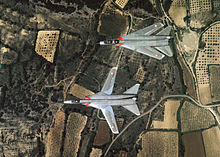
Back جناح متعدد الأوضاع Arabic Ala de geometria variable Catalan Měnitelná geometrie křídla Czech Variabel pilgeometri Danish Schwenkflügel German Ala de geometría variable Spanish بال متحرک FA Muuttuvageometrinen siipi Finnish Voilure à géométrie variable French כנף בעלת גאומטריה משתנה HE


A variable-sweep wing, colloquially known as a "swing wing", is an airplane wing, or set of wings, that may be modified during flight, swept back and then returned to its previous straight position. Because it allows the aircraft's shape to be changed, it is a feature of a variable-geometry aircraft.
A straight wing is most efficient for low-speed flight, but for an aircraft designed for transonic or supersonic flight it is essential that the wing be swept. Most aircraft that travel at those speeds usually have wings (either swept wing or delta wing) with a fixed sweep angle. These are simple and efficient wing designs for high speed flight, but there are performance tradeoffs. One is that the stalling speed is increased, necessitating long runways (unless complex high-lift wing devices are built in). Another is that the aircraft's fuel consumption during subsonic cruise is higher than that of an unswept wing. These tradeoffs are particularly acute for naval carrier-based aircraft. A variable-sweep wing allows the pilot to use the optimum sweep angle for the aircraft's speed at the moment, whether slow or fast. The more efficient sweep angles available offset the weight and volume penalties imposed by the wing's mechanical sweep mechanisms. Its greater complexity and cost make it practical mostly for military aircraft.
A number of aircraft, both experimental and production, were introduced between the 1940s and the 1970s. The majority of production aircraft to be furnished with variable-sweep wings have been strike-oriented aircraft, such as the Mikoyan-Gurevich MiG-27, Tupolev Tu-22M, and Panavia Tornado. The configuration was also used for a few fighter/interceptor aircraft, including the Mikoyan-Gurevich MiG-23, Grumman F-14 Tomcat, and the Panavia Tornado ADV. From the 1980s onwards, the development of such aircraft were curtailed by advances in flight control technology and structural materials which have allowed designers to closely tailor the aerodynamics and structure of aircraft, removing the need for variable sweep angle to achieve the required performance; instead, wings are given computer-controlled flaps on both leading and trailing edges that increase or decrease the camber or chord of the wing automatically to adjust to the flight regime; this technique is another form of variable geometry.